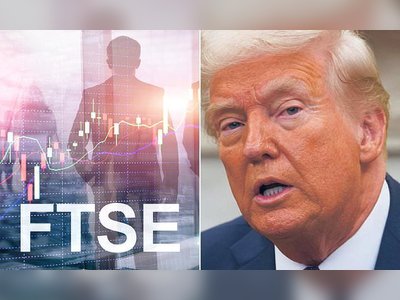
The tech cold war is hotting up TikTok and the Sino-American tech split
Over the past few years countless predictions have been made that the global technology industry will suffer a painful rupture because of tensions between America and China. Real damage has been surprisingly hard to spot. Last year Apple made over $100m of sales a day in China, while Huawei reported record revenues despite America’s campaign to cripple it. Investors have piled into tech companies’ shares, buoyed by the prospect of new technologies such as 5G and a pandemic that is forcing billions of customers to spend more time and money online.
Judged by sales, profits and shareholder returns, it has been a golden era for American and Chinese tech. The industry now has a colossal market capitalisation of $20trn and accounts for a quarter of the world’s stockmarket value.
Yet if you examine the events of the past two weeks you can sense the split that is about to come. On July 6th Mike Pompeo, America’s secretary of state, said that the administration was considering banning TikTok, a Chinese-run app that is wildly popular in the West. This followed India’s decision a week earlier to prohibit it, and 58 other Chinese apps, after lethal brawls between soldiers in the Himalayas.
Britain and France are considering sidelining Huawei from their 5G networks (see article). Between July 6th and 7th Facebook, Google, Microsoft and Twitter all said that they will stop co-operating with Hong Kong’s authorities for the time being, because of the introduction of China’s brutal security law there. And SMIC, China’s aspiring semiconductor champion, has just said that it will raise $7bn in a state-supported listing in Shanghai—it delisted from New York last year (see article). The proceeds will be used to supersize China’s home-grown chipmaking capacity.
The split is happening at two velocities. The American and Chinese software and internet universes are heading at light-speed towards total separation. They were never particularly connected—American software firms made just 3% of their sales in China last year, and China has long kept its internet users isolated from the world. The bill for shutting up shop and finding substitute products is usually low.
TikTok creates few jobs and pays little or no tax in America or India, so the main cost of banning it is sullen teenagers. Likewise, Facebook and the other firms taking a stand in Hong Kong do little or no business in China. Two important exceptions have been Microsoft’s office software and, especially, Google’s system of apps like Gmail and Maps, found on Chinese-made phones sold worldwide. America’s blacklisting of Huawei has cut off the world’s second-biggest phone seller from some of the world’s most popular apps. Chinese handset firms are racing to develop an alternative. The American and Chinese software worlds are thus quickly becoming entirely separate universes.
Hardware is moving much more slowly. That is because it is more globally integrated and involves $1trn of physical plant and $400bn of inventories. Later this year Apple will launch a new 5G handset that will still rely on the same vast manufacturing cluster in China that it used five years ago. Even so, the techtonic plates are shifting.
Because of a new set of American restrictions on the use of chipmaking tools put in place in May, Huawei may run out of stock of its specialist chips in early 2021 and will have to scramble to find an alternative.
That will be cumbersome and costly. The SMIC capital-raising shows that China intends to create a chip giant on a par with Intel or Taiwan’s TSMC, although it will take years to do so. If Britain and France both eventually ditch Huawei, they will shift to using Nokia and Ericsson in their networks, which will be expensive and take several years.
If the splintering now seems inevitable, there will be some surprises. One is how the two technospheres of influence are drawn. American policymakers tend to assume the world will use Silicon Valley products, but plenty of countries may ally with China’s tech system or hedge their bets.
India is frosty towards both American and Chinese digital firms and hopes to build up its own champions, although it cannot compete yet in hardware. Another surprise is how much the split could cost. The global listed hardware industry has annual expenses of $600bn, much of which may need to be replicated. Plenty of key firms, including Apple and TSMC, are equally dependent on America and China and have no clear plan to cope with a deeper divide. The tech split is under way. Do not assume it will happen safely.
Yet if you examine the events of the past two weeks you can sense the split that is about to come. On July 6th Mike Pompeo, America’s secretary of state, said that the administration was considering banning TikTok, a Chinese-run app that is wildly popular in the West. This followed India’s decision a week earlier to prohibit it, and 58 other Chinese apps, after lethal brawls between soldiers in the Himalayas.
Britain and France are considering sidelining Huawei from their 5G networks (see article). Between July 6th and 7th Facebook, Google, Microsoft and Twitter all said that they will stop co-operating with Hong Kong’s authorities for the time being, because of the introduction of China’s brutal security law there. And SMIC, China’s aspiring semiconductor champion, has just said that it will raise $7bn in a state-supported listing in Shanghai—it delisted from New York last year (see article). The proceeds will be used to supersize China’s home-grown chipmaking capacity.
The split is happening at two velocities. The American and Chinese software and internet universes are heading at light-speed towards total separation. They were never particularly connected—American software firms made just 3% of their sales in China last year, and China has long kept its internet users isolated from the world. The bill for shutting up shop and finding substitute products is usually low.
TikTok creates few jobs and pays little or no tax in America or India, so the main cost of banning it is sullen teenagers. Likewise, Facebook and the other firms taking a stand in Hong Kong do little or no business in China. Two important exceptions have been Microsoft’s office software and, especially, Google’s system of apps like Gmail and Maps, found on Chinese-made phones sold worldwide. America’s blacklisting of Huawei has cut off the world’s second-biggest phone seller from some of the world’s most popular apps. Chinese handset firms are racing to develop an alternative. The American and Chinese software worlds are thus quickly becoming entirely separate universes.
Hardware is moving much more slowly. That is because it is more globally integrated and involves $1trn of physical plant and $400bn of inventories. Later this year Apple will launch a new 5G handset that will still rely on the same vast manufacturing cluster in China that it used five years ago. Even so, the techtonic plates are shifting.
Because of a new set of American restrictions on the use of chipmaking tools put in place in May, Huawei may run out of stock of its specialist chips in early 2021 and will have to scramble to find an alternative.
That will be cumbersome and costly. The SMIC capital-raising shows that China intends to create a chip giant on a par with Intel or Taiwan’s TSMC, although it will take years to do so. If Britain and France both eventually ditch Huawei, they will shift to using Nokia and Ericsson in their networks, which will be expensive and take several years.
If the splintering now seems inevitable, there will be some surprises. One is how the two technospheres of influence are drawn. American policymakers tend to assume the world will use Silicon Valley products, but plenty of countries may ally with China’s tech system or hedge their bets.
India is frosty towards both American and Chinese digital firms and hopes to build up its own champions, although it cannot compete yet in hardware. Another surprise is how much the split could cost. The global listed hardware industry has annual expenses of $600bn, much of which may need to be replicated. Plenty of key firms, including Apple and TSMC, are equally dependent on America and China and have no clear plan to cope with a deeper divide. The tech split is under way. Do not assume it will happen safely.











